The Desiccant Bags Market is estimated to be valued at USD 2.7 billion in 2025 and is projected to reach USD 5.0 billion by 2035, registering a compound annual growth rate (CAGR) of 6.5% over the forecast period.
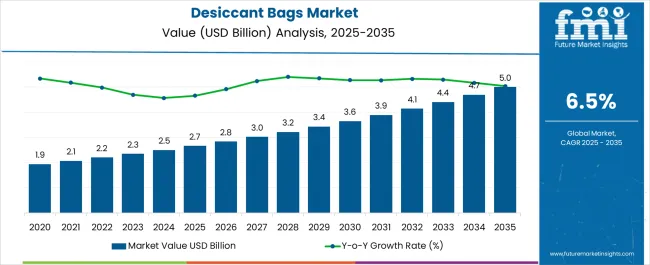
| Metric | Value |
|---|---|
| Desiccant Bags Market Estimated Value in (2025 E) | USD 2.7 billion |
| Desiccant Bags Market Forecast Value in (2035 F) | USD 5.0 billion |
| Forecast CAGR (2025 to 2035) | 6.5% |
The Desiccant Bags Market is witnessing steady growth, supported by the rising need for effective moisture control solutions across diverse industries such as food, pharmaceuticals, electronics, and logistics. Growing global trade and longer product transit times are amplifying the importance of reliable packaging protection, as moisture exposure can compromise quality, safety, and shelf life. Desiccant bags are increasingly used to prevent mold growth, corrosion, and product degradation during storage and shipping, making them an integral part of supply chain management.
Technological advancements in desiccant material formulations and eco-friendly options are further boosting adoption. Companies are prioritizing packaging integrity due to stricter regulations in food and pharmaceutical industries, creating sustained demand for high-performance moisture control systems.
With the continued expansion of e-commerce and global distribution networks, the role of desiccant bags as a cost-effective and scalable packaging solution is being reinforced Rising awareness about reducing product loss and enhancing brand reputation through secure packaging is expected to drive long-term growth for this market worldwide.
The desiccant bags market is segmented by desiccant material type, capacity, application, and geographic regions. By desiccant material type, desiccant bags market is divided into Silica Gel, Calcium Oxide, and Calcium Sulphate. In terms of capacity, desiccant bags market is classified into 20 To 100 Grams, Less Than 20 Grams, 100 To 200 Grams, 200 To 500 Grams, 500 To 1000 Grams, and Above 1000 Grams.
Based on application, desiccant bags market is segmented into Food, Electronics, Shipping, Military, and Pharmaceutical Packaging. Regionally, the desiccant bags industry is classified into North America, Latin America, Western Europe, Eastern Europe, Balkan & Baltic Countries, Russia & Belarus, Central Asia, East Asia, South Asia & Pacific, and the Middle East & Africa.
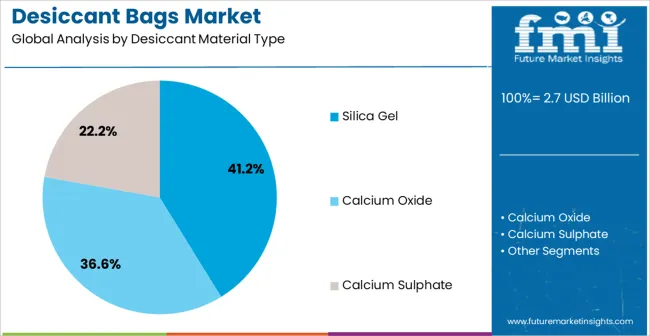
The silica gel desiccant material type segment is projected to account for 41.2% of the market share in 2025, positioning it as the dominant material category. Silica gel is preferred due to its high adsorption capacity, chemical stability, and non-toxic nature, making it suitable for sensitive applications. Its ability to maintain low relative humidity levels ensures prolonged protection for products vulnerable to moisture damage, including food items, pharmaceuticals, and electronics.
Ease of regeneration and wide availability have further strengthened its adoption across industries. Additionally, silica gel provides consistent performance even under fluctuating temperature and humidity conditions, which enhances its reliability in global shipping and storage. Manufacturers are leveraging its versatility to design customized packaging solutions that meet regulatory and consumer safety standards.
Growing demand for sustainable packaging solutions has also encouraged the development of eco-friendly silica gel options, expanding its appeal With its proven track record and cost-effectiveness, silica gel remains the most widely adopted desiccant material, ensuring its continued leadership in the market.
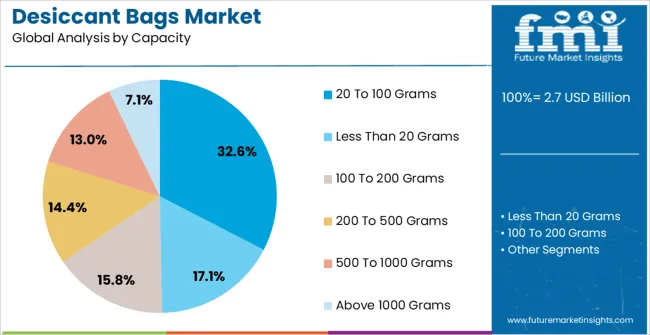
The 20 to 100 grams capacity segment is expected to hold 32.6% of the market share in 2025, highlighting its strong presence in the desiccant bags industry. This capacity range is widely favored for its suitability in packaging medium-sized goods, where effective moisture control is required without occupying excessive space. It is particularly useful in shipping cartons, small storage containers, and product packages where moderate protection is necessary.
Manufacturers are increasingly offering 20 to 100 gram desiccant bags in user-friendly formats, such as tear-resistant pouches and environmentally safe materials, which are gaining traction among industries with strict packaging standards. The balance between adsorption efficiency and portability makes this segment cost-effective for businesses seeking reliable moisture protection.
Growth is further reinforced by rising demand in global logistics and e-commerce, where medium-capacity desiccant bags help ensure product safety during transportation As industries prioritize optimal moisture control with efficient use of packaging space, the 20 to 100 gram segment is anticipated to maintain its market strength.
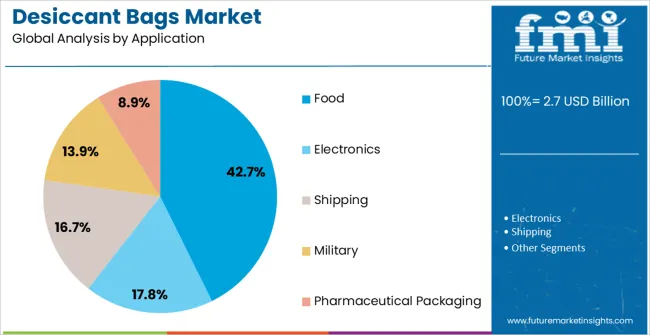
The food application segment is anticipated to account for 42.7% of the desiccant bags market share in 2025, making it the leading application area. Growth is primarily driven by increasing global demand for packaged and processed food products, which require strict protection from moisture-related spoilage. Desiccant bags are widely used to prevent mold growth, clumping, and loss of freshness in food products, especially those with extended shelf life requirements.
Regulatory compliance in the food industry has reinforced the adoption of food-grade desiccants that meet safety and quality standards. Innovations in eco-friendly and non-toxic desiccant formulations are enhancing their appeal among food manufacturers aiming to align with sustainability goals. Growing international trade and longer shipping durations are further amplifying the need for reliable moisture control in food packaging.
As consumers increasingly demand high-quality and safe packaged food, the role of desiccant bags in maintaining product integrity and brand reputation is becoming indispensable This is expected to secure the food application segment’s leadership in the market.
Desiccant bags are the flexible small pouches that are filled with the desiccant material. Desiccant bags are also called as moisture absorber bags. Desiccant material is a hygroscopic (a substance that can absorb moisture from air) material used in various applications such as food, electronics, shipping, medical devices, military, and automobile industry etc.
The desiccant bags absorb moisture in the packaging of the products which require to be protected from moisture which can cause corrosion and degradation. Desiccant bags maintains quality and shelf life of the packaged products. Desiccant absorbs humidity until they are inside the packet. The desiccant material is filled in the paper bag or sachet and after absorption of moisture the desiccant turns into gel.
The demand for desiccant bags is expected to increase over the forecast period. Desiccant bags are used in almost every industry so the growth in any industry will increase the growth of the desiccant bags market. In shipping of sea cargo in closed containers, the desiccant bags are used in order to absorb the moisture.
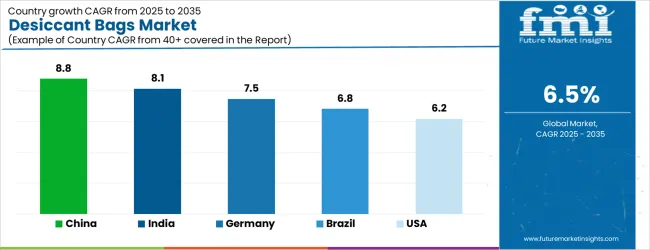
| Country | CAGR |
|---|---|
| China | 8.8% |
| India | 8.1% |
| Germany | 7.5% |
| Brazil | 6.8% |
| USA | 6.2% |
| UK | 5.5% |
| Japan | 4.9% |
The Desiccant Bags Market is expected to register a CAGR of 6.5% during the forecast period, exhibiting varied country level momentum. China leads with the highest CAGR of 8.8%, followed by India at 8.1%. Developed markets such as Germany, France, and the UK continue to expand steadily, while the USA is likely to grow at consistent rates.
Japan posts the lowest CAGR at 4.9%, yet still underscores a broadly positive trajectory for the global Desiccant Bags Market. In 2024, Germany held a dominant revenue in the Western Europe market and is expected to grow with a CAGR of 7.5%.
The USA Desiccant Bags Market is estimated to be valued at USD 943.3 million in 2025 and is anticipated to reach a valuation of USD 943.3 million by 2035. Sales are projected to rise at a CAGR of 0.0% over the forecast period between 2025 and 2035. While Japan and South Korea markets are estimated to be valued at USD 137.2 million and USD 88.5 million respectively in 2025.
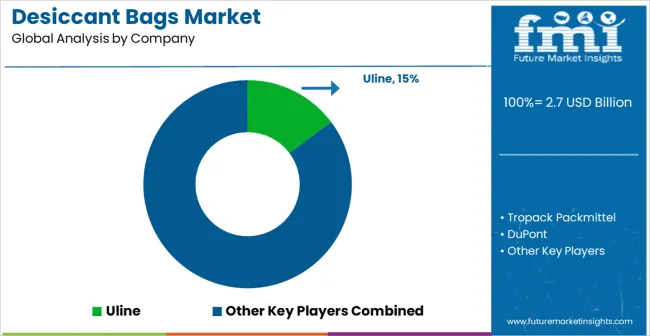
| Item | Value |
|---|---|
| Quantitative Units | USD 2.7 Billion |
| Desiccant Material Type | Silica Gel, Calcium Oxide, and Calcium Sulphate |
| Capacity | 20 To 100 Grams, Less Than 20 Grams, 100 To 200 Grams, 200 To 500 Grams, 500 To 1000 Grams, and Above 1000 Grams |
| Application | Food, Electronics, Shipping, Military, and Pharmaceutical Packaging |
| Regions Covered | North America, Europe, Asia-Pacific, Latin America, Middle East & Africa |
| Country Covered | United States, Canada, Germany, France, United Kingdom, China, Japan, India, Brazil, South Africa |
| Key Companies Profiled | Uline, Tropack Packmittel, DuPont, Samuel Grant Packaging, Desiccare, Dhatec, Clariant, Brownell, Edco Supply, Capsule Connection, Foil Packaging, and Prestige Technology |
The global desiccant bags market is estimated to be valued at USD 2.7 billion in 2025.
The market size for the desiccant bags market is projected to reach USD 5.0 billion by 2035.
The desiccant bags market is expected to grow at a 6.5% CAGR between 2025 and 2035.
The key product types in desiccant bags market are silica gel, calcium oxide and calcium sulphate.
In terms of capacity, 20 to 100 grams segment to command 32.6% share in the desiccant bags market in 2025.






Our Research Products

The "Full Research Suite" delivers actionable market intel, deep dives on markets or technologies, so clients act faster, cut risk, and unlock growth.

The Leaderboard benchmarks and ranks top vendors, classifying them as Established Leaders, Leading Challengers, or Disruptors & Challengers.

Locates where complements amplify value and substitutes erode it, forecasting net impact by horizon

We deliver granular, decision-grade intel: market sizing, 5-year forecasts, pricing, adoption, usage, revenue, and operational KPIs—plus competitor tracking, regulation, and value chains—across 60 countries broadly.

Spot the shifts before they hit your P&L. We track inflection points, adoption curves, pricing moves, and ecosystem plays to show where demand is heading, why it is changing, and what to do next across high-growth markets and disruptive tech

Real-time reads of user behavior. We track shifting priorities, perceptions of today’s and next-gen services, and provider experience, then pace how fast tech moves from trial to adoption, blending buyer, consumer, and channel inputs with social signals (#WhySwitch, #UX).

Partner with our analyst team to build a custom report designed around your business priorities. From analysing market trends to assessing competitors or crafting bespoke datasets, we tailor insights to your needs.
Supplier Intelligence
Discovery & Profiling
Capacity & Footprint
Performance & Risk
Compliance & Governance
Commercial Readiness
Who Supplies Whom
Scorecards & Shortlists
Playbooks & Docs
Category Intelligence
Definition & Scope
Demand & Use Cases
Cost Drivers
Market Structure
Supply Chain Map
Trade & Policy
Operating Norms
Deliverables
Buyer Intelligence
Account Basics
Spend & Scope
Procurement Model
Vendor Requirements
Terms & Policies
Entry Strategy
Pain Points & Triggers
Outputs
Pricing Analysis
Benchmarks
Trends
Should-Cost
Indexation
Landed Cost
Commercial Terms
Deliverables
Brand Analysis
Positioning & Value Prop
Share & Presence
Customer Evidence
Go-to-Market
Digital & Reputation
Compliance & Trust
KPIs & Gaps
Outputs
Full Research Suite comprises of:
Market outlook & trends analysis
Interviews & case studies
Strategic recommendations
Vendor profiles & capabilities analysis
5-year forecasts
8 regions and 60+ country-level data splits
Market segment data splits
12 months of continuous data updates
DELIVERED AS:
PDF EXCEL ONLINE
Desiccants Market Size and Share Forecast Outlook 2025 to 2035
Desiccant Dehumidifiers Market Size, Growth, and Forecast 2025 to 2035
Desiccant Wheel Market Growth - Trends & Forecast 2025 to 2035
Desiccant Paper Market
Gas Desiccant Dehydration Unit Market Size and Share Forecast Outlook 2025 to 2035
Polybags Market Size and Share Forecast Outlook 2025 to 2035
Net Bags Market
VCI Bags Market
Sandbags Market
Leno Bags Market Size and Share Forecast Outlook 2025 to 2035
Silo bags Market Size and Share Forecast Outlook 2025 to 2035
Food Bags Market Share, Size, and Trend Analysis for 2025 to 2035
Competitive Breakdown of Silo Bag Manufacturers
Clay Desiccant Bag Market
Paper Bags Market Size and Share Forecast Outlook 2025 to 2035
Jumbo Bags Market Size and Share Forecast Outlook 2025 to 2035
Blood Bags Market Size and Share Forecast Outlook 2025 to 2035
Craft Bags Market Growth, Trends, Forecast 2025 to 2035
Market Share Breakdown of Craft Bags Manufacturers
Competitive Breakdown of Paper Bags Providers

Thank you!
You will receive an email from our Business Development Manager. Please be sure to check your SPAM/JUNK folder too.
Chat With
MaRIA